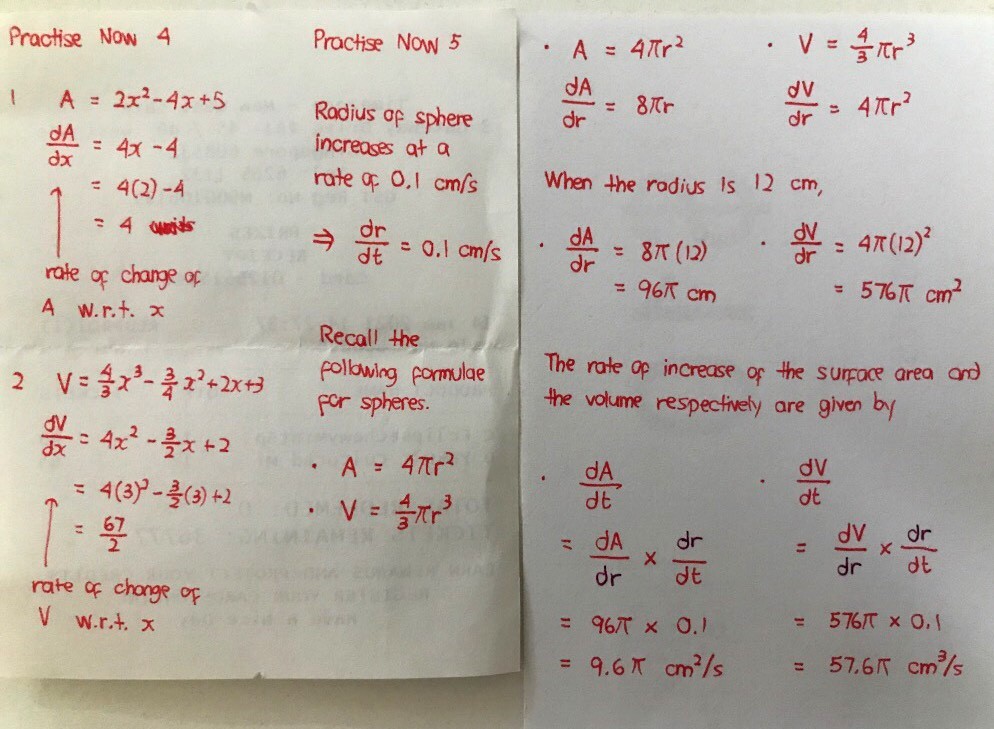Eric Nicholas K's answer to LockB's Secondary 4 A Maths Singapore question.
done
{{ upvoteCount }} Upvotes
clear
{{ downvoteCount * -1 }} Downvotes
Practise Now 4, Practise Now 5
Date Posted:
3 years ago
rate of change is basically dy/dx?
dont really understand practice now 5 tho...
dont really understand practice now 5 tho...
Rate of change is basically the study of how one variable changes as another variable changes.
dy/dx is basically a measure of how y changes as x changes for a particular curve (which is again yet another way of expressing the word gradient). Thus, dy/dx can be called the rate of change of y with respect to x.
When the rate of change involves time, we are simply measuring how fast a quantity is changing with time. For example, we know that speed = distance / time. We can say that speed is a measure of how fast the distance changes, so speed can be said to be the rate of change of distance (s) with time (t); this can be written as ds/dt.
In Practise Now 5, we are dealing with even more difficult scenarios. Connected rates of change. In many circumstances, the change of a variable can affect yet another variable.
For example, when we inflate a balloon, it is not just the radius which changes. The surface area and the volume also changes! We wish to find, say, how fast the volume changes when the radius changes constantly. And so on. We wish to know how changing the radius affects the change in volume - will it always be a constant increase? Will the balloon volume increase faster if the radius gets larger? And so on.
dy/dx is basically a measure of how y changes as x changes for a particular curve (which is again yet another way of expressing the word gradient). Thus, dy/dx can be called the rate of change of y with respect to x.
When the rate of change involves time, we are simply measuring how fast a quantity is changing with time. For example, we know that speed = distance / time. We can say that speed is a measure of how fast the distance changes, so speed can be said to be the rate of change of distance (s) with time (t); this can be written as ds/dt.
In Practise Now 5, we are dealing with even more difficult scenarios. Connected rates of change. In many circumstances, the change of a variable can affect yet another variable.
For example, when we inflate a balloon, it is not just the radius which changes. The surface area and the volume also changes! We wish to find, say, how fast the volume changes when the radius changes constantly. And so on. We wish to know how changing the radius affects the change in volume - will it always be a constant increase? Will the balloon volume increase faster if the radius gets larger? And so on.
In this question, we wish to find out how the surface area of a sphere changes as its radius increases constantly.
The rate of change of surface area is called dA/dt. The rate of change of the radius is called dr/dt.
These two are clearly related expressions, because the surface area of a balloon increases every time a balloon is inflated to a greater radius.
But how do we link them together? We link these two using a connector expression dA/dr using the equation
dA/dt = dA/dr times dr/dt.
We are given a constant, fixed value for dr/dt. We are tasked to find the value of dA/dt. To do this, we need to connect them using dA/dr. But, this must be obtained from an equation for A in terms of r. This is easy because we know the formula for the curved surface area of a sphere.
From there, we can write an expression for dA/dr before proceeding to solve the question.
The rate of change of surface area is called dA/dt. The rate of change of the radius is called dr/dt.
These two are clearly related expressions, because the surface area of a balloon increases every time a balloon is inflated to a greater radius.
But how do we link them together? We link these two using a connector expression dA/dr using the equation
dA/dt = dA/dr times dr/dt.
We are given a constant, fixed value for dr/dt. We are tasked to find the value of dA/dt. To do this, we need to connect them using dA/dr. But, this must be obtained from an equation for A in terms of r. This is easy because we know the formula for the curved surface area of a sphere.
From there, we can write an expression for dA/dr before proceeding to solve the question.
is the rate of change and rate of increase different? as i dont understand why the answer isnt 96pi and 57pi (like practice now 4)
still dont really understand the part on "the rate of increase of the surface area and volume....."
still dont really understand the part on "the rate of increase of the surface area and volume....."
Rate of change and rate of increase is similar, just like “percentage change” versus “percentage increase”.
I look at the rates of change again later.
I look at the rates of change again later.
ok
"the rate of increase of the surface area and volume....."
Basically we are required to obtain an expression for dA/dt and dV/dt.
Unfortunately, we do not have these values directly, so we must make use of other expressions to obtain our required expressions.
dA/dt can be found by multiplying dA/dr by dr/dt, both quantities of which can be found easily because we already know the value of dr/dt and we can easily calculate the value of dA/dr when r = 12, considering that the area mentioned here is the surface area of a sphere.
dV/dt is similar and we use dV/dr times dr/dt.
Basically we are required to obtain an expression for dA/dt and dV/dt.
Unfortunately, we do not have these values directly, so we must make use of other expressions to obtain our required expressions.
dA/dt can be found by multiplying dA/dr by dr/dt, both quantities of which can be found easily because we already know the value of dr/dt and we can easily calculate the value of dA/dr when r = 12, considering that the area mentioned here is the surface area of a sphere.
dV/dt is similar and we use dV/dr times dr/dt.
hi Mr Eric, although this question is from 3months ago, is the rate of increase (dont really remember if it is increase or decrease) always negative regardless of the signage of the answer you obtained?
for example i got 0.886cm^3/s as my answer, but the question is asking for rate of increase, so i will have to add a negative sign to make it - 0.886cm^3/s
for example i got 0.886cm^3/s as my answer, but the question is asking for rate of increase, so i will have to add a negative sign to make it - 0.886cm^3/s
When we calculate dV/dt or something like that, it’s always a change with respect to the positive. So if the answer is -0.886, then it means the increase is -0.886, or basically this is a decrease of 0.886.
sorry! i still dont really understand when to add a negative sign to an answer....
by the way are you able to help with some questions on integration of partial fractions?
by the way are you able to help with some questions on integration of partial fractions?



